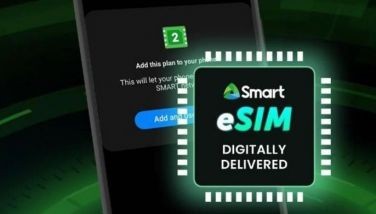Smart beefs up operations in Southern Tagalog, Bicol
October 13, 2001 | 12:00am
Smart Communications Inc. has announced the full operations of its GSM switch in Lucena City, the third GSM switch fired up by Smart in a month, beefing up its network capacity in Southern Luzon and parts of the Bicol region by 350,000 more subscribers.
"The full operations of Smart’s GSM switch in Lucena will help us in enabling local communities in the Southern Tagalog and Bicol region by providing them with cutting-edge wireless services of unparalleled quality, affordability and reliability," Smart president and chief executive officer Napoleon Nazareno said.
Located at the PLDT facility in Lucena City, Quezon, the new switch serves the provinces of Quezon, Laguna, Romblon, Albay, Camarines Sur and Camarines Norte.
Prior to the activation of the Lucena GSM switch, mobile traffic in the region was being processed by Smart’s Tambo GSM switch in Metro Manila.
"By installing our GSM switch for Calabarzon and Bicol in Lucena City, call and text traffic management is improved, enhancing Smart’s overall network quality and coverage for our subscribers," Smart network services division head Rolando Peña said.
Peña said Lucena City is definitely a good location with growth potentials and a large market for wireless services given the low teledensities in the two regions.
Called the Coco Palm City of Southern Luzon, Lucena is considered as one of the growth centers of the Southeast Calabarzon Corridor. It is the gateway to Southern Tagalog, Metro Manila and other parts of mainland Luzon from the Bicol region and island-provinces of Marinduque, Masbate, Palawan and Romblon.
Teledensities in terms of subscribed lines for Southern Tagalog (Region 4) and Bicol (Region 5), as of end-2000, have not reached double-digit figures (4.17 and 1.28, respectively).
Aside from the DX200i model Mobile Switching Center (MSC), the Lucena GSM switch also houses a Home Location Register (HLR), a Short Message Service Center (SMSC), a Prepaid Service Node, a Transit Mobile Switching Center and a Fiber Optic Transmission System. The network equipment is supplied by Nokia Networks.
GSM switch facilities are the core of a cellular network. Cellular call signals are picked up by the nearest radio base station and transmitted to the Base Station Controller. The BSC, in turn, relays the signal to the Mobile Switching Center which then processes the call and routes it to the appropriate mobile or fixed line destination.
In effect, additional mobile switches increase the capacity of the network and makes the management system of call and text traffic more efficient.
Smart’s GSM network, as of end-June 2001, has a capacity for over six million subscribers. Actual subscriber base figure, including Piltel’s Talk N Text, which also runs on Smart’s network, is pegged at five million for the same period.
To handle the significant increase in voice and text traffic volume, Smart recently signed a $200-million GSM expansion program with Nokia Networks, targeting a 10 million subscriber capacity by next year. Smart’s network expansion program for this year is estimated at P21 billion.
A subsidiary of dominant Philippine carrier PLDT, Smart now has the country’s largest capacity network. It has transformed itself from a cellular operator to a full wireless services provider, offering wireless services such as Smart Money, the internationally acclaimed electronic cash card linked to a cellular phone, and Smart zed, the mobile portal for personalized services. — Mary Ann Ll. Reyes
"The full operations of Smart’s GSM switch in Lucena will help us in enabling local communities in the Southern Tagalog and Bicol region by providing them with cutting-edge wireless services of unparalleled quality, affordability and reliability," Smart president and chief executive officer Napoleon Nazareno said.
Located at the PLDT facility in Lucena City, Quezon, the new switch serves the provinces of Quezon, Laguna, Romblon, Albay, Camarines Sur and Camarines Norte.
Prior to the activation of the Lucena GSM switch, mobile traffic in the region was being processed by Smart’s Tambo GSM switch in Metro Manila.
"By installing our GSM switch for Calabarzon and Bicol in Lucena City, call and text traffic management is improved, enhancing Smart’s overall network quality and coverage for our subscribers," Smart network services division head Rolando Peña said.
Peña said Lucena City is definitely a good location with growth potentials and a large market for wireless services given the low teledensities in the two regions.
Called the Coco Palm City of Southern Luzon, Lucena is considered as one of the growth centers of the Southeast Calabarzon Corridor. It is the gateway to Southern Tagalog, Metro Manila and other parts of mainland Luzon from the Bicol region and island-provinces of Marinduque, Masbate, Palawan and Romblon.
Teledensities in terms of subscribed lines for Southern Tagalog (Region 4) and Bicol (Region 5), as of end-2000, have not reached double-digit figures (4.17 and 1.28, respectively).
Aside from the DX200i model Mobile Switching Center (MSC), the Lucena GSM switch also houses a Home Location Register (HLR), a Short Message Service Center (SMSC), a Prepaid Service Node, a Transit Mobile Switching Center and a Fiber Optic Transmission System. The network equipment is supplied by Nokia Networks.
GSM switch facilities are the core of a cellular network. Cellular call signals are picked up by the nearest radio base station and transmitted to the Base Station Controller. The BSC, in turn, relays the signal to the Mobile Switching Center which then processes the call and routes it to the appropriate mobile or fixed line destination.
In effect, additional mobile switches increase the capacity of the network and makes the management system of call and text traffic more efficient.
Smart’s GSM network, as of end-June 2001, has a capacity for over six million subscribers. Actual subscriber base figure, including Piltel’s Talk N Text, which also runs on Smart’s network, is pegged at five million for the same period.
To handle the significant increase in voice and text traffic volume, Smart recently signed a $200-million GSM expansion program with Nokia Networks, targeting a 10 million subscriber capacity by next year. Smart’s network expansion program for this year is estimated at P21 billion.
A subsidiary of dominant Philippine carrier PLDT, Smart now has the country’s largest capacity network. It has transformed itself from a cellular operator to a full wireless services provider, offering wireless services such as Smart Money, the internationally acclaimed electronic cash card linked to a cellular phone, and Smart zed, the mobile portal for personalized services. — Mary Ann Ll. Reyes
BrandSpace Articles
<
>
- Latest
Latest
Latest
February 22, 2024 - 3:17pm
February 22, 2024 - 3:17pm
December 28, 2023 - 12:00am
December 28, 2023 - 12:00am
December 11, 2023 - 11:00am
December 11, 2023 - 11:00am
November 23, 2023 - 4:35pm
November 23, 2023 - 4:35pm
October 16, 2023 - 5:00pm
October 16, 2023 - 5:00pm
Recommended






























